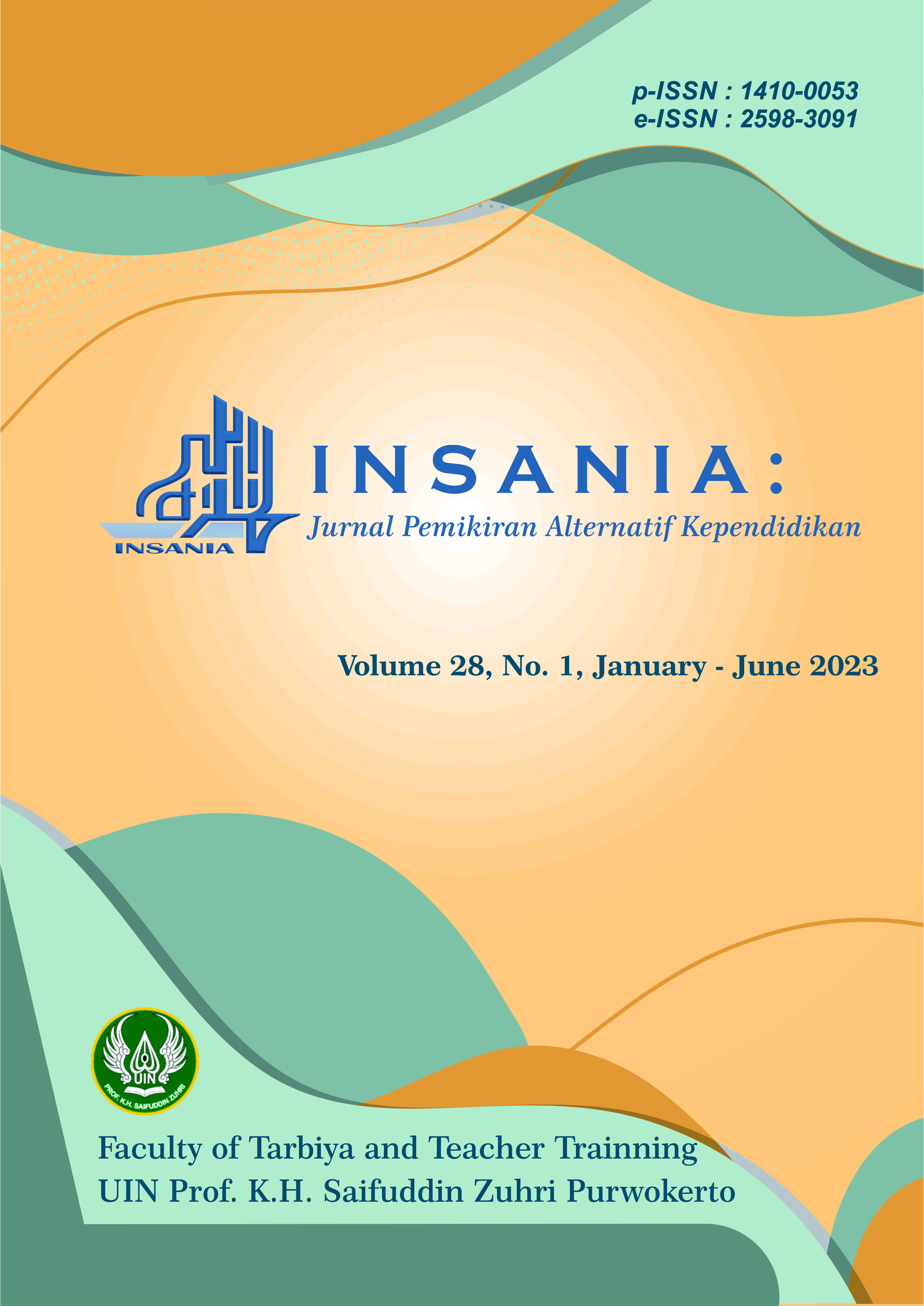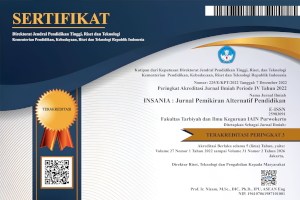The effect of usability, information quality, and accessibility on the intensity of the madrasa website use at Madrasah Aliyah level
DOI:
https://doi.org/10.24090/insania.v28i1.7925Keywords:
usability, information quality, accessibility, intensity, madrasa websiteAbstract
The majority of academic communities in madrasa access the madrasa website infrequently. It is related to the user’s perception of the madrasa website’s quality. This study seeks to determine how usability, information quality, and accessibility effect the frequency with which madrasa websites are visited. This study proposes a correlational quantitative research methodology. The research cohort consisted of 2401 MAN Surakarta students, and the sample size was 96. The method of sampling is proportional random sampling. Data collection techniques using a questionnaire. Techniques of data analysis utilizing correlation analysis and single regression to test the hypotheses of single correlation, correlation, and multiple regression. The results of the study indicate that: 1) Usability has a positive effect on the intensity of website use; 2) Information quality has a positive effect on the intensity of website use; 3) Accessibility has a positive effect on the intensity of website use; and 4) Usability, information quality, and accessibility all have a positive effect on the intensity of website use. Usability, information quality, and accessibility collectively contribute 51.1% to the website's intensity, while the remaining 48.9% is influenced by unmeasured variables.Downloads
References
Aarseth, E. J. J. (1997). Cybertext: Perspectives on ergodic literature. The Johns Hopkins University Press.
Andiputra, K. & Tanamal, R. (2020). Analisis usability menggunakan metode Webuse pada website kitabisa.com. Business Management Journal, 16(1), 11–15. http://dx.doi.org/10.30813/bmj.v16i1.2051
Andarwati, S.R., & Sankarto, B.S. (2005). Pemenuhan kepuasan penggunaan internet oleh peneliti badan litbang pertanian di Bogor. Jurnal Perpustakaan Pertanian, 14(1), 10-17.
Aynayya, Q., Saputra, M. C., & Pramono, D. (2018). Evaluasi usability dan rekomendasi perbaikan tampilan website seleksi mahasiswa (SELMA) Universitas Brawijaya. Jurnal Pengembangan Teknologi Informasi dan Ilmu Komputer, 2(4), 6-14. https://j-ptiik.ub.ac.id/index.php/j-ptiik/article/view/1288
Barnes, S. J., and Vidgen, R.T. (2001). Assessing the quality of auction web sites. Proceedings of the 34th Annual Hawai International Conference on System Sciences, 34, 10. https://doi.org/10.1109/HICSS.2001.927087
Barnes, S.J, Vidgen R.T. (2003). Measuring website quality improvement : A case study of the forum on strategic management knowledge exchange. Journal of Industrial Management and Data Systems, 103(5), 297–309. https://doi.org/10.1108/02635570310477352
Cheng, Y. H. (2011). Evaluating web site service quality in public transport: Evidence from taiwan high speed rail. Transportation Research Part C: Emerging Technologies, 19(6), 957-974. https://doi.org/10.1016/j.trc.2011.04.003
Chiew, T.K. & Salim, S.S. (2003).Webuse: Website usability evaluation tool. Malaysian Journal of Computer Science, 6(1), 47–57. https://citeseerx.ist.psu.edu/pdf/4441c12a1a723c3de998c394cf4a63a5996cc58c
Creswell, J.W. (2012). Research design: Qualitative & quantitative approach. Sage Publication.
DeLone, W. H., & McLean, E. R. (1992). Information systems success: The quest for the dependent variable. Information Systems Research, 3(1), 60-95. https://doi.org/10.1287/isre.3.1.60
DeLone, W. H., & McLean, E. R. (2003). The DeLone and McLean model of information systems success: A ten- year update management information system. Journal of Management Information Systems, 19(4), 9-30. https://doi.org/10.1080/07421222.2003.11045748
Henry, S.L. (2002). Understanding web accessibility. In Web accessibility (pp. 1-51). Apress. http://dx.doi.org/10.1007/978-1-4302-0188-5_1
Horrigan, J. B. (2002). New Internet Users:What They Do Online, What They Don’t, And Implications For The ‘Net’s Future. Journal Pew Internet and American Life Project. https://www.pewinternet.org/wp-content/uploads/sites/9/media/Files/ Reports/2000/New_User_Report.pdf.pdf, 1-27
Krisdiantoro, Y., Subekti, I., & Prihatiningtias, Y.W., (2018). Pengaruh kualitas sistem dan kualitas informasi terhadap manfaat bersih dengan intensitas penggunaan sebagai variabel mediasi. Jurnal Akuntansi Aktual, 5(2), 149-167. http://dx.doi.org/10.17977/um004v5i32019p261
Krupitzer, C., Müller, S., Lesch, V., Züfle, M., Edinger, J., Lemken, A., Schäfer, D., Kounev, S., & Becker, C. (2020). A Survey on Human Machine Interaction in Industry 4.0. arXiv preprint arXiv:2002.01025. https://doi.org/10.48550/arXiv.2002.01025
Livari, J. (2005). An empirical test of the model of information system success. The Data Base for Advances in Information Systems, 36(2), 8–27. https://doi.org/10.1145/1066149.1066152
McLeod, R., & Schell, G. P. (2004). Management information systems, 7th Edition. Prentice Hall Inc.
Mora, S. L. (2013). Web accessibility among the countries of the European Union: A comparative study. Journal Actual Problems of Computer Science (APCS), 3(1), 18-27. http://rua.ua.es/dspace/handle/10045/41437
Nielsen, J. (1994). Guerrilla HCI: Using discount usability engineering to penetrate the intimidation barrier [Online]. http://www.useit.com/papers/guerrilla_hci.html.
Nielsen J. (2000). Designing web usability: The practice of simplicity. New Riders Publishing.
Novianti, A.G., dan Widirahayu, M.D.A. (2015). Aksesibilitas website pemerintah kota Jayapura oleh masyarakat kota Jayapura. Jurnal DINAMIS, 2(12), 11–19. https://ojs.ustj.ac.id/dinamis/article/view/517
Petrie, H., and Bevan, N. (2009). The evaluation of accessibility, usabilitas (usability)and user experience. In C. Stepanidis (ed), The Universal Access Handbook (pp. 1–30). CRC Press. https://doi.org/10.1201/9781420064995-c20
Setiawan, A., & Tanumihardja, D. (2017). Penerapan tata kelola perguruan tinggi melalui transparansi informasi di website. Research Report - Humanities and Social Science, Universitas Katolik Parahyangan, Bandung, Indonesia.
Smith, A.D. (2004). Information exchanges associated with internet travel marketplaces. Online Information Review, 28(4), 292–300. https://doi.org/10.1108/14684520410553787
Tangahu, W., Rahmat, A., & Husain, R. (2021). Modern education in revolution 4.0. International Journal of Innovations in Engineering Research and Technology [IJIERT], 8(1), 1–5. https://repo.ijiert.org/index.php/ijiert/article/view/2
Wahyuni, T. (2011). Uji empiris model DeLone and McLean terhadap kesuksesan sistem informasi manajemen daerah (SIMDA). Jurnal Badan Pendidikan dan Pelatihan Keuangan (BPPK), 2(3), 9–18. https://doi.org/10.48108/jurnalbppk.v2i0.51
Wako, T. N. (2003). Education Management Information Systems (EMIS): A Guide for Young Managers. UNESCO, Unesdoc Digital Library. https://unesdoc.unesco.org/ark:/48223/pf0000220621
Yuliana, E., dan Wardini, T.M. (2013). Students’ accessibility and intensity to the online tutorial program. Jurnal Pendidikan Terbuka dan Jarak Jauh, 14(1), 24–32. https://jurnal.ut.ac.id/index.php/jptjj/article/view/390
Downloads
Published
How to Cite
Issue
Section
License
Copyright (c) 2023 Novi

This work is licensed under a Creative Commons Attribution-ShareAlike 4.0 International License.
Authors who publish with this journal agree to the following terms:
Authors retain copyright and grant the journal right of first publication with the work simultaneously licensed under a Creative CommonsAttribution-ShareAlike License that allows others to share the work with an acknowledgment of the work's authorship and initial publication in this journal.
Authors are able to enter into separate, additional contractual arrangements for the non-exclusive distribution of the journal's published version of the work (e.g., post it to an institutional repository or publish it in a book), with an acknowledgment of its initial publication in this journal.
Authors are permitted and encouraged to post their work online (e.g., in institutional repositories or on their website) prior to and during the submission process, as it can lead to productive exchanges, as well as earlier and greater citation of published work (See The Effect of Open Access).









